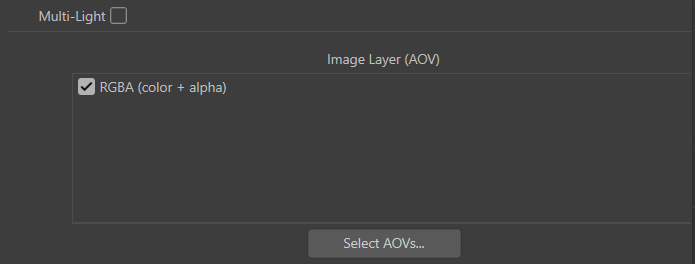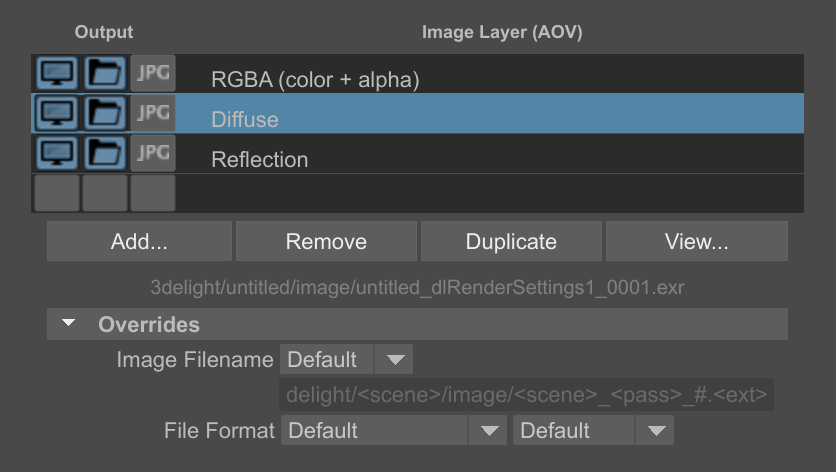| Excerpt Include | ||||||
|---|---|---|---|---|---|---|
|
The Image Layers group
Global Options
Default Image Filename
Specifies the default file location for the image layers. By default, the location is based on the scene name, the render pass name and the AOV name. See File Path Expressions for details on how it is possible to construct relative paths and paths containing dynamically expanded tokens.
Default Image Format
Specifies the default file format for the image layers, including the pixel bit depth. The default is 16-bit float EXR files.
The supported file formats are:
...
TIFF
...
.tif
...
TIFF format.
...
8-bit integer
16-bit integer
32-bit float
...
OpenEXR
...
The Open EXR format.
OpenEXR is a high dynamic-range (HDR) image file format developed by Industrial Light & Magic.
...
16-bit float
32-bit float
___________
...
OpenEXR (deep)
...
.exr...
The Open EXR "deep" image format (introduced in Open EXR 2.0).
Each pixel can contain multiple values at different depths.
...
16-bit float
32-bit float
...
JPEG
...
8-bit integer
...
PNG
...
8-bit integer
16-bit integer
...
| Info |
|---|
8-bit images are saved with a sRGB gamma correction. 16-bit integer, 16-bit float and 32-bit float images are saved as "raw" data, without any gamma correction. |
Batch Output Mode
Each image layer have a file output toggle controlling wether it should be saved to file during rendering. Since these toggles may be manipulated frequently while working interactively and may be forgotten in a off position when sending the rendering to a render farm (using the Cinema4D Batch command line), the Batch Output Mode controls wether these toggles should be ignored (overridden) when rendering in batch mode. This option is useful to make sure all image layers are saved when rendering using the Cinema4D Batch command line, regardless of the status of the file output toggle. The options are:
...
Enable file output as selected
...
Enable all file output and selected JPEG
...
List of Layers (AOVs)
Note that during batch output, JPEG files are always output as specified by the JPEG toggle.
Interactive Output Mode
The Interactive Output Mode allows to globally control the behaviour of the file output toggles while working during an interactive session. The options are:
...
Enable file output as selected
...
Disable file output
...
Enable file output only for selected displays
...
Image Layers (AOVs) List
...
The second section of the Image Layers group is use used to specify the list all the layers that will be generated during the rendering process (subject to the selection of any of the three output toggles in te the list). By default, the list is populated with only one image layer, the RGBA ("Beauty") layer. When there are many layers, it is possible to re-order them in the list for organisational purpose (to visually group them). This is done through a middle-click and drag. It is a bit finicky to use though - you need to drop the layer while a line in between two layers is highlighted for the re-order to work. If you drop the layer while another layer is highlighted, nothing happens.
...
Each layer can be selected to be displayed on screen while rendering or be saved to file or both. They can be saved in the specified format and also simultaneously in JPEG (similar in concept to a digital camera that can save simultaneously a RAW and a JPEG image). These outputs (display on screen and save to file) for each layer is controlled using
...
the options on the Output menu.
If the toggle on the image layer is being selected, it means that that layer will be rendered to display, image or other output, as specified on the Output menu. Below the list of layers there is one button used to add the layers you want to render on AOV List.
Select AOVs
...
...
...
display on screen
...
Enables the display of the image layer in a window on screen: either in the Cinema4D Render View or 3Delight Display. The selection of which window (and accordingly which application) is a user preference that can be specified in the 3Delight Preferences.
Unlike 3Delight Display, the Cinem4D Render View does not support to display simultaneously multiple layers. When this toggle is enable for multiple layers, only the first one is displayed.
...
file output
...
Enables the output of the image layer to file using the file format and location specified by the Default Image Filename and Default Image Format attributes (unless overridden for that layer in the options listed below the list of layers).
...
jpeg output
...
Enables the output of the image layer as a JPEG. The file location is the same as specified for the standard file, only this time with the .jpg extension.
If all three toggles are selected, the image layer will be outputted simultaneously in a screen window, on file and as a jpeg. Below the list of layers there are four buttons. Except for Add, their function applies to the selected layers in the list:
...
...
For adding layers. The AOV Selector will pop for enabling one or more AOVs. All the AOVs selected in the AOV Selector are presented
...
Remove
Select one or more layers in the list and press Remove to remove. Note that the RGBA ("Beauty") layer can not be removed.
Duplicate
...
in the list
...
of
...
layers
...
View...
Select a layer and press View to view it. This opens the Image Filename for that layer in a viewing application. Refer to the 3Delight Preferences for how to select which application should be launched.
Per Layer Attributes
When selecting a layer (only one) in the list of layers, its attributes are listed in collapsable groups below the Add/Remove/Duplicate/View buttons. These are per-layer attributes. The expanded file name for the selected layer is shown just above these collapsable groups.
Groups of attributes for a specific Layer
...
...
...
This group is to override the following attributes for the selected layer:
Image Filename
Use to override the Default Image Filename. The options are "Default" to use (not override) the Default Image Filename and "Custom" to specify a custom filename for the selected layer. When default is selected, the complete expanded filename is listed just below (expanded from the token).
File Format
To override the Default Image Format. The options are "Default" to use (not override) the Default Image Format and "Custom" to specify a custom file format, including the pixel bit depth.
...




